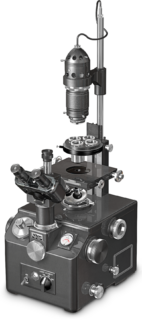Nikon’s Museum of Microscopy
Model M Inverted Microscope
( Circa early 1970s )
Built in the early 1970s, this black-enameled inverted microscope was designed for both biological (diascopic) and metallurgical (episcopic) use with brightfield and phase contrast illumination.

The microscope is equipped with an episcopic illuminator built into the side of the base as well as a diascopic illuminator positioned on supporting post above the stage. The microscope has optical accessories enabling the use of phase contrast, interference contrast, photomicrography, and cinemicrography. A four- or five-objective turret fitted with either brightfield/darkfield or phase contrast objectives swivels on a mount at the center of the top surface of the instrument body. Directly beneath the objective turret, within the body, is a change-over prism containing both a half- and total-reflecting prism for control of illumination and the optical pathway. The binocular or optional trinocular viewing head is equipped with several Huygens eyepieces and can be rotated to any position and secured with a lock screw. The condenser, positioned on the lamphouse supporting post, has four slots that are designed to hold phase rings and filters. There are several ports on the microscope for external camera attachment or for addition of a data illuminator, which was used to show or register an arrow, cross line, or square over the image in the viewfield.
Control switches for the illumination selection and main power are on the front of the body below the head. On the right-hand side of the main body is a monocular straight eyepiece tube. Photomicrography accessories for this microscope include the Microflex model AFM, EFM, and PFM camera systems and a straight eyepiece tube for a motion-picture camera. The microscope is also equipped with a cine auto-timer that automatically releases the shutter at pre-set intervals for taking quick motion-pictures. For demonstration purposes, a projection screen accessory is provided. Biologists doing tissue culture can take advantage of the constant-temperature incubator accessory, made of transparent plastic, that has a fan for circulating the air within the chamber.
Today Nikon offers a number of different upright microscope models tailored for various applications.















